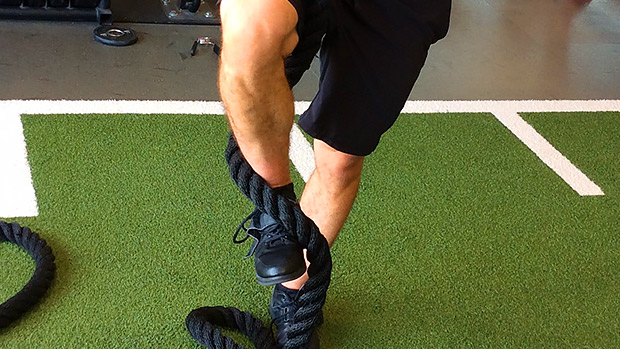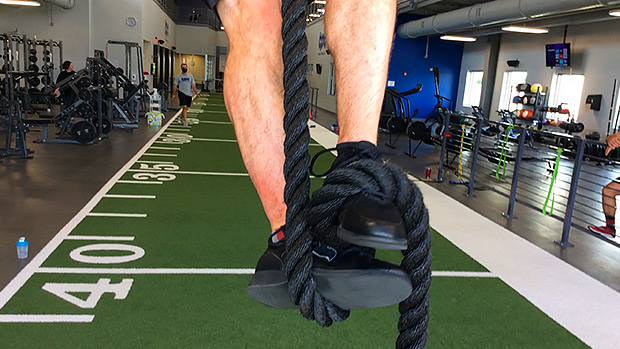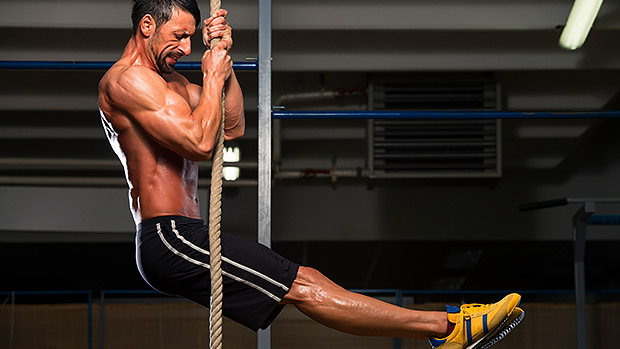Having a strong grip allows your muscles to tighten appropriately, leading to a better transfer of force into the weight you're about to lift. A stronger grip generally means a stronger person, and many studies have concluded that people with a stronger grip actually live longer.
One of the best old-school ways to improve your grip is with rope climbing. Not only will it fire up your forearms, biceps, and lats, it's also a killer workout for your core.
Here are a couple ways to climb up a rope that'll build some serious grip strength... and add a little fun to your workouts.
S-Wrap Rope Climb
This is the most secure way to attach your leg to the rope and requires the least amount of arm strength. The downside? It's typically a slower climb. It's also harder to hike your knees up, and you can easily get rope burn on your lower leg using this technique if you are not wearing the proper attire.
You wrap your entire leg around the rope for this variation. Do this by taking your leg on the outside of the rope, and wrap the rope around your lower leg allowing part of it to go on top of your shoelaces.

When going up, try to keep your wrapped leg in constant contact with the rope. This will allow you to more easily "clamp" your free foot onto your foot that's in the rope. The goal should be to clamp the rope between your feet.
When lowering yourself to the floor, release your free leg and allow yourself to lower down the rope a bit at time. Clamp your free leg back onto the rope to secure your lower body when you need to bend your elbows to lower down further.
J-Hook Rope Climb
This one's significantly faster than the last, and significantly easier to hike up your knees for your next pull. The downside is that you have less contact points with the rope which could make this climb feel less secure. It also requires more arm strength.
This is the technique that competitive CrossFitters use to get up and down the rope as fast as possible.

Place the outside of your dominant foot on the rope. As you pull up, use your non-dominant foot to "scoop" the rope so that it goes on top of your shoelaces.
Then clamp your non-dominant foot onto your dominant foot to secure your lower body to the rope. Try to keep the rope in the center of your body when climbing. This will make it significantly easier to re-hook your legs.
When lowering yourself down, keep the side of your dominant foot in contact with the rope. Use your non-dominant foot to pull up on the rope so that it becomes more taught. This will make it easier to move your legs down the rope without losing contact.
Arms-Only Running Man Rope Climb
This climb requires significant arm strength. The upside is the amount of arm strength you'll gain from doing it. The downside is that you need a decent amount of strength to even try it.
To execute it smoothly, forcefully drive your opposite knee up as you pull with your opposite arm. This will give you a better center of gravity and will allow your natural momentum to aid you as you scale the rope.
Arms-Only Straddled Leg Climb
This is a level up from the running man climb. It requires significant core strength to keep your legs in the straddle position, as well as a lot of arm strength to get yourself up the rope. Keep your core engaged for the entire duration of the climb. Be explosive with each pull and stay tight.
Upside Down or "Spider-Man" Climb
This requires significant coordination between your hands and feet. When going up, you'll want to use your foot and toes to "grip" the rope. Similar to the running man climb, you'll want to go opposite arm and opposite leg to keep your momentum going upward.
Make sure you do a few practice runs while staying low to the ground. You don't want to miss a step if you're high on the rope.
Before Rope Climbing...
- Never slide down the rope without going hand-over-hand, unless you enjoy severe rope burn.
- Wear high socks or pants if you want to minimize rope burn on your lower leg/thigh if you're doing the S-wrap or the J-hook.
- Get comfortable with the S-wrap and J-hook before going high on the rope with the arms-only climbs. This will ensure you can save yourself should your arms tire out if you get high up.





